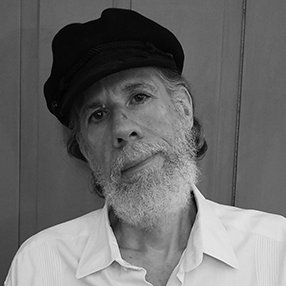The Trouble Ball [excerpt]
for my father, Frank Espada In 1941, my father saw his first big league ballgame at Ebbets Field in Brooklyn: the Dodgers and the Cardinals. My father took his father's hand. When the umpires lumbered on the field, the band in the stands with a bass drum and trombone struck up a chorus of Three Blind Mice. The peanut vendor shook a cowbell and hollered. The home team raced across the diamond, and thirty thousand people shouted all at once, as if an army of liberation rolled down Bedford Avenue. My father shouted, too. He wanted to see The Trouble Ball. On my father's island, there were hurricanes and tuberculosis, dissidents in jail and baseball. The loudspeakers boomed: Satchel Paige pitching for the Brujos of Guayama. From the Negro Leagues he brought the gifts of Baltasar the King; from a bench on the plaza he told the secrets of a thousand pitches: The Trouble Ball, The Triple Curve, The Bat Dodger, The Midnight Creeper, The Slow Gin Fizz, The Thoughtful Stuff. Pancho Coímbre hit rainmakers for the Leones of Ponce; Satchel sat the outfielders in the grass to play poker, windmilled three pitches to the plate, and Pancho spun around three times. He couldn't hit The Trouble Ball. At Ebbets Field, the first pitch echoed in the mitt of Mickey Owen, the catcher for the Dodgers who never let the ball escape his glove. A boy off the boat, my father shelled peanuts, waiting for Satchel Paige to steer his gold Cadillac from the bullpen to the mound, just as he would navigate the streets of Guayama. Yet Satchel never tipped his cap that day. ¿Dónde están los negros? asked the boy. Where are the Negro players? No los dejan, his father softly said. They don't let them play here. Mickey Owen would never have to dive for The Trouble Ball. It was then that the only brown boy at Ebbets Field felt himself levitate above the grandstand and the diamond, another banner at the ballgame. From up high he could see that everyone was white, and their whiteness was impossible, like snow in Puerto Rico, and just as silent, so he could not hear the cowbell, or the trombone, or the Dodger fans howling with glee at the bases-loaded double. He understood why his father whispered in Spanish: everybody in the stands might overhear the secret of The Trouble Ball. At Ebbets Field in 1941, the Dodgers met the Yankees in the World Series. Mickey Owen dropped the third strike with two outs in the ninth inning of Game Four, flailing like a lobster in the grip of a laughing fisherman, and the Yankees stamped their spikes across the plate to win. Brooklyn, the borough of churches, prayed for his fumbling soul. This was the reason statues of the Virgin leaked tears and the fathers of Brooklyn drank, not the banishment of Satchel Paige to doubleheaders in Bismarck, North Dakota. There were no rosaries or boilermakers for The Trouble Ball. My father would return to baseball on 108th Street. He pitched for the Crusaders, kicking high like Satchel, riding the team bus painted with four-leaf clovers, seasick all the way to Hackensack or the Brooklyn Parade Grounds. One day he jammed his wrist sliding into second, threw three more innings anyway, and never pitched again. He would return to Ebbets Field to court my mother. The same year they were married a waiter refused to serve them, a mixed couple sitting all night in the corner, till my father hoisted him by his lapels and the waiter's feet dangled in the air, a puppet and his furious puppeteer. My father was familiar with The Trouble Ball. I was born in Brooklyn in 1957, when the Dodgers packed their duffle bags and left the city. A wrecking ball swung an uppercut into the face of Ebbets Field. I heard the stories: how my mother, lost in the circles and diamonds of her scorecard, never saw Jackie Robinson accelerate down the line to steal home. I wore my father's glove until the day I laid it down to lap the water from the fountain in the park. By the time I raised my head, it was gone like Ebbets Field. I walked slowly home. I had to tell my father I would never learn to catch The Trouble Ball. There was a sign below the scoreboard at Ebbets Field: Abe Stark, Brooklyn's Leading Clothier. Hit Sign, Win Suit. Some people see that sign in dreams. They speak of ballparks as cathedrals, frame the pennants from the game where it began, Dodger blue and Cardinal red, and gaze upon the wall. My father, who remembers everything, remembers nothing of that dazzling day but this: ¿Dónde están los negros? No los dejan. His hair is white, and still the words are there, like the ghostly imprint of stitches on the forehead from a pitch that got away. It is forever 1941. It was The Trouble Ball.
Credit
From The Trouble Ball, published by W.W. Norton. Copyright © 2011 by Martín Espada. Used by permission of the publisher. All rights reserved.
Date Published
01/01/2011

